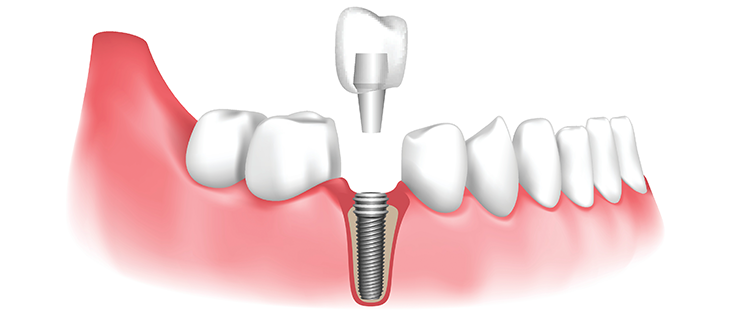Get This Report about Dental Sense
Get This Report about Dental Sense
Blog Article
Dental Sense - The Facts
Table of ContentsThe Buzz on Dental SenseLittle Known Questions About Dental Sense.8 Easy Facts About Dental Sense DescribedHow Dental Sense can Save You Time, Stress, and Money.
are clinical tools operatively implanted into the jaw to restore an individual's ability to eat or their appearance. They provide assistance for synthetic (fake) teeth, such as crowns, bridges, or dentures. When a tooth is lost as a result of injury or disease, an individual can experience difficulties such as fast bone loss, defective speech, or changes to chewing patterns that result in discomfort.Oral dental implant systems consist of an oral implant body and dental implant joint and may also include an abutment addiction screw. Dental implant vs bridge. The dental implant body is surgically placed in the jawbone instead of the tooth's origin. The oral implant joint is usually affixed to the implant body by the abutment fixation screw and prolongs via gum tissues right into the mouth to support the connected man-made teeth
(https://pubhtml5.com/homepage/vtrmy/)Framework of The Oral Implant System choosing oral implants, speak with your oral copyright regarding the possible advantages and threats, and whether you are a candidate for the procedure. Things to consider: Your overall wellness is a vital consider determining whether you are an excellent prospect for dental implants, how much time it will require to heal, and the length of time the dental implant may stay in location.
Cigarette smoking may impact the healing procedure and reduce the long-term success of the implant. The recovery procedure for the implant body might take a number of months or longer, throughout which time you normally have a temporary joint in area of the tooth. the dental implant treatment: Meticulously comply with the oral hygiene guidelines given to you by your dental company.
How Dental Sense can Save You Time, Stress, and Money.
Implant failure can cause the requirement for an additional medical treatment to take care of or replace the implant system. Brings back the capacity to eat Restores aesthetic appearance Aids maintain the jawbone from diminishing because of bone loss Protects the health of the surrounding bone and gum tissues Helps maintain surrounding (neighboring) teeth secure Boosts lifestyle Damage to bordering all-natural teeth during dental implant positioning Injury to the surrounding cells during surgery, such as sinus perforation Injury throughout surgical treatment (for instance, crack of bordering jawbone) Insufficient function, such as really feeling like the teeth do not attack together typically A sensation that the tooth is loosened or twisting in area resulting from a joint screw loosening Implant body failure (looseness of the dental implant body) because of systemic infection, which may be most likely in individuals with unchecked diabetics issues as a result of neighborhood infection in bone and gum tissues sustaining the dental implant body as a result of delayed recovery, which might be most likely in people who smoke Problem cleaning the periodontals around the dental implant, resulting in poor dental hygiene Without treatment periodontal disease Post-surgical pins and needles as a result of nerve impingement or damages Constantly inform health and wellness care service providers and imaging professionals that you have oral implants before any magnetic vibration imaging (MRI) or x-ray procedures.
FDA is not aware of any type of damaging events reported for MRI or x-ray treatments with dental implants. Oral implants systems are typically made from materials that comply with worldwide agreement standards of the International Organization for Standardization (ISO) or ASTM International. These criteria have information of what makes a safe product.

An oral implant is a framework that replaces a missing tooth. With screw-like gadgets, the specialist inserts a dental implant right into the jawbone, and it acts as an anchor for an artificial tooth, called a crown.
The 10-Minute Rule for Dental Sense
Some people are not eligible for oral implant surgery. It is for dental surgeons to operate on individuals with: acute illnessuncontrollable metabolic diseasebone or soft tissue illness or infectionIf these problems are solved, an individual can have the surgical procedure. In, dental cosmetic surgeons refrain from operating on individuals with: If people with any of the above undergo dental implant surgery, there is a higher risk of the implant falling short.

Dental dental implant surgery is a personalized procedure. It's not the Read Full Report same for everybody. The following provides a general overview of what you can anticipate your dental expert, oral cosmetic surgeon, periodontist or prosthodontist to do: Place the dental implant operatively. Offer you time to heal. Connect the post and last crown, bridge or denture.
Next, your cosmetic surgeon will meticulously position the oral implant into your jaw. Your doctor will certainly rearrange your gum tissues and close the laceration with stitches. If your implant is near the front of your mouth, your dental professional will make a short-lived tooth for you to use up until you heal. By doing this, you will not have a void in your smile while you recoup.
Dental Sense for Beginners
During the recovery stage, your jawbone must fuse to the oral implant. This procedure can take anywhere from 3 to 9 months.
Once your implant heals, your dental professional can connect the abutment (tiny port message) and your last restoration (crown, bridge or denture). This normally takes concerning one hour to finish and may need a 2nd small surgery. You shouldn't feel any kind of pain throughout your dental implant procedure because your copyright will certainly make use of drug to numb your gums.
Report this page